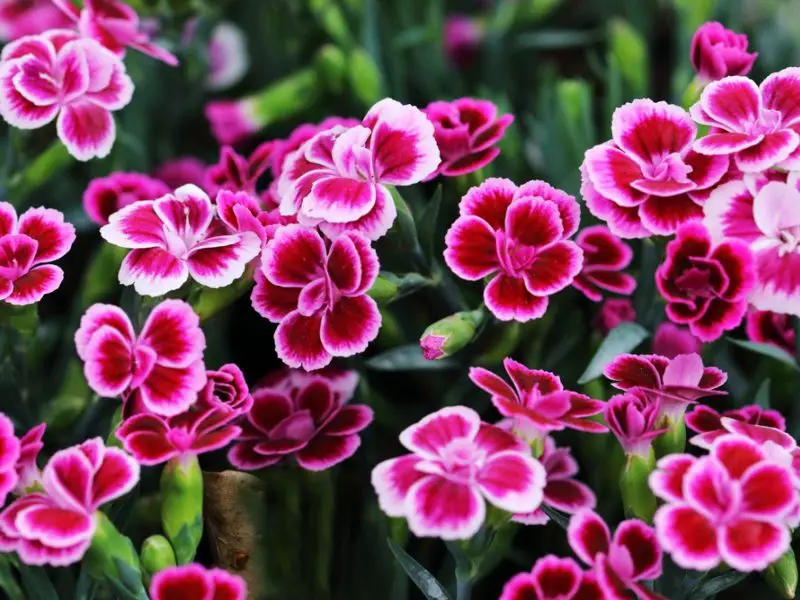Dianthus, with its vibrant hues and delightful fragrance, is a garden favorite that brings charm and elegance to any landscape. Whether you’re growing pinks, carnations, or Sweet William, these blooms thrive when given the right care—no matter where you live. From sunny balconies in the south to cool patios in the north, Dianthus can flourish beautifully with just a little know-how.
In this complete guide, you’ll discover everything you need to care for Dianthus in every climate. Learn how to keep the flowers blooming longer, protect them from weather stress, and choose the right varieties for your region. Whether you’re a beginner or a seasoned gardener, these expert-backed tips will help your Dianthus thrive season after season.
Understanding the Needs of Dianthus

Sunlight Requirements
Dianthus is a sun-loving plant that performs best under ample light. Ideally, most varieties prefer full sun exposure, meaning at least 6 to 8 hours of direct sunlight each day. This level of light encourages compact growth, vibrant color, and abundant flowering. In cooler climates, full sun is essential to maximize blooming potential and to prevent legginess. However, in hotter or arid regions, where the afternoon sun can be intense, partial shade during the hottest part of the day can protect the foliage from sunburn and keep blooms from wilting prematurely. If you’re growing Dianthus in containers, consider relocating pots as needed to optimize light exposure throughout the seasons.
Soil Preferences
The ideal soil for Dianthus is light, well-draining, and slightly alkaline, typically with a pH between 6.5 and 7.5. Poorly draining soils can lead to root rot, one of the most common issues for Dianthus, especially in wet climates. To improve heavy or compacted soils, work in coarse sand, perlite, or well-rotted compost before planting. In acidic soils, adding a bit of garden lime can help balance pH and create a more suitable growing environment. Consistent drainage is critical, whether planting in the ground or in raised beds and containers. Avoid soggy areas or low spots in the garden where water collects after rain.
Watering Guidelines
Dianthus prefers moderately dry conditions once established. Overwatering is a common mistake that can lead to root rot, crown rot, or mildew. The key is to water deeply but less frequently, allowing the top inch of soil to dry out before watering again. In cooler or more humid climates, this may mean watering only once or twice a week. In warmer or windy environments, more frequent watering may be needed, but always monitor soil moisture first. Morning watering is best, as it allows the leaves to dry quickly and reduces the chance of fungal issues. If watering overhead, avoid wetting the foliage whenever possible.
Feeding for Optimal Growth
Feeding Dianthus at the right time with the right nutrients can greatly improve bloom quality and longevity. Begin in early spring with a balanced slow-release fertilizer—ideally one with equal parts nitrogen, phosphorus, and potassium, such as a 10-10-10 formula. This supports steady root and shoot growth during the early growing season. Once flower buds appear, switch to a liquid bloom booster rich in phosphorus (like a 5-10-5) to encourage prolific flowering. Apply every 3 to 4 weeks during active bloom periods. Be cautious with nitrogen-rich formulas, which may result in lush green leaves but few flowers. In nutrient-poor soils, a layer of compost in early spring can also serve as a natural fertilizer.
Seasonal Care by Climate Zone
Dianthus in Cold Climates (USDA Zones 3–5)
In colder regions, choose hardy perennial dianthus varieties that can survive winter conditions. Plant them in spring once the danger of frost has passed. Apply a thick layer of mulch in late fall to insulate the crown from freezing temperatures. Regular deadheading will encourage continued blooming throughout the season. After flowering ends, trim the plants back to maintain a neat appearance and stimulate compact, healthy regrowth the following year.
Dianthus in Temperate Climates (USDA Zones 6–7)
These zones provide ideal growing conditions for most dianthus types. You can plant in either spring or fall, depending on your gardening schedule. Good air circulation is essential to prevent issues like powdery mildew. Feed the plants every few weeks during the growing season and trim spent flowers regularly to prolong blooming from late spring into early fall. For perennial varieties, divide clumps every two to three years to prevent overcrowding and encourage fresh, vigorous growth.
Dianthus in Warm Climates (USDA Zones 8–9)
In warmer regions, dianthus often performs best as a cool-season annual or short-lived perennial. Plant in early fall to enjoy flowers through the winter and into spring. Select heat-tolerant varieties that can handle mild winters and brief temperature spikes. Provide some afternoon shade during hotter days to prevent stress. A light layer of mulch will help conserve moisture and keep the roots cool without creating too much humidity around the plant base.
Dianthus in Hot and Humid Climates (USDA Zones 10–11)
In tropical and subtropical zones, treat dianthus as a seasonal plant suited for the cooler months. Start seeds or transplants in late fall when temperatures begin to drop. Use containers or raised beds with excellent drainage to prevent root rot. Choose mildew-resistant varieties, and space plants well apart to improve air movement and reduce fungal risk. Promptly remove faded blooms to minimize the chance of disease and keep the plants looking their best throughout the season.
Pruning and Deadheading Techniques
Pest and Disease Management
Common Pests
While dianthus is relatively pest-resistant, certain insects can still become problematic in the right conditions. Aphids typically gather on new growth and buds, sucking sap and potentially spreading disease. Spider mites thrive in hot, dry environments and leave behind fine webbing and stippled foliage. Cutworms, which hide in the soil during the day, may chew through stems at the base, especially in young plants. To manage these pests, inspect plants weekly—especially the undersides of leaves—and act early. Use a forceful stream of water to dislodge aphids or mites. For persistent infestations, apply organic insecticidal soap or neem oil every 7–10 days. Planting companion plants like dill or yarrow can also attract beneficial predators such as ladybugs, lacewings, and parasitic wasps, creating a balanced ecosystem in your garden.
Disease Prevention
Dianthus is susceptible to several fungal diseases, particularly in humid or overly wet environments. Leaf spots, powdery mildew, and root rot are among the most common problems. To prevent these, adopt good watering practices by irrigating at the soil level rather than overhead. Water early in the day so foliage can dry quickly. Spacing plants properly allows for airflow, reducing humidity around the leaves. Mulching can also help limit soil splash, which may spread fungal spores. At the first sign of disease—such as yellowing leaves, black spots, or powdery residue—remove and discard affected foliage to stop the spread. Avoid composting diseased materials unless your compost pile reaches high enough temperatures to kill pathogens.
Soil-Borne Issues
One of the most serious threats to dianthus is crown rot, caused by overly wet or compacted soil. This disease causes the base of the plant to turn mushy and dark, often leading to collapse. To avoid this, plant dianthus in raised beds, containers, or well-amended garden soil that drains freely. Do not bury the crown too deeply; it should sit slightly above the soil line. Annual soil rotation can also reduce pathogen buildup—avoid planting dianthus in the same spot each year if diseases have previously occurred. Incorporating organic matter such as compost or coarse sand improves drainage and soil structure, further reducing the risk of root-related problems.
Propagation Methods for Dianthus
Growing from Seeds
Starting dianthus from seeds is an affordable and rewarding method, especially for annual varieties. Begin sowing seeds indoors 6 to 8 weeks before your region’s final frost date. Sprinkle seeds on the surface of moist, sterile seed-starting mix and gently press them down without covering, as they need light to germinate. Maintain a consistent temperature of 65–70°F and provide bright light. Germination usually occurs within 7 to 14 days. Once seedlings develop two sets of true leaves, thin them and transplant them outdoors after the last frost, gradually acclimating them to outdoor conditions.
Division of Mature Plants
Dividing mature dianthus clumps helps refresh older plants, prevent overcrowding, and increase bloom production. This method works best for perennial types and should be done in early spring or early fall when the plant is dormant or temperatures are mild. Carefully dig up the plant and shake off excess soil to expose the root system. Use your hands or a sterile knife to separate the crowns, ensuring each new section has healthy roots and shoots. Replant immediately at the same depth in well-draining soil and water thoroughly to help the divisions establish.
Stem Cuttings
Propagating dianthus from stem cuttings is a quick way to clone a healthy parent plant and ensure identical flowers. Choose a 4- to 6-inch-long shoot without buds or blooms in late spring or early summer. Cut just below a leaf node and remove the lower leaves. Dip the cut end in rooting hormone to speed up root development, then plant it in a moist mix of perlite and peat or coarse sand. Cover with a humidity dome or clear plastic bag to retain moisture, and place the container in bright, indirect light. Roots typically form within three to four weeks, after which the new plant can be hardened off and moved to the garden.
Using Dianthus in Garden Design
Troubleshooting Common Problems
Yellowing Leaves
Yellowing leaves on dianthus often indicate stress caused by overwatering, poor drainage, or nutrient imbalances. Overly saturated soil deprives roots of oxygen, leading to root damage and chlorosis. To fix this, check soil moisture regularly and water only when the top inch feels dry. Improving soil drainage by amending with organic matter or planting in raised beds can prevent waterlogging. Additionally, a lack of essential nutrients like nitrogen, iron, or magnesium can cause yellowing. Applying a balanced, slow-release fertilizer or a foliar feed with micronutrients will restore healthy green foliage.
Wilting Plants
Wilting is usually a sign of water stress or root problems. If the soil is dry, increase watering frequency but avoid soggy conditions that cause root rot. Roots damaged by fungal pathogens cannot absorb water efficiently, leading to wilting even in moist soil. Improving drainage and removing infected roots can save the plant. During hot spells, high temperatures increase evaporation and plant transpiration, causing wilting. Moving potted plants to shaded areas or using shade cloth outdoors during peak heat helps reduce stress. Mulching also keeps soil cooler and retains moisture.
No Blooms
A lack of flowers can be frustrating and often results from environmental or cultural issues. Dianthus needs adequate sunlight—typically 4 to 6 hours of direct sun daily—for healthy flower production. Plants grown in deep shade may grow leggy but produce few or no blooms. Excess nitrogen fertilizer encourages lush leaf growth at the expense of flowers, so use balanced or bloom-boosting fertilizers with higher phosphorus content. Additionally, stress from irregular watering, pest damage, or overcrowding can inhibit blooming. Regularly pinch back stems to encourage branching and more flower buds.
Leaf Spots and Mildew
Fungal diseases like leaf spot and powdery mildew thrive in humid, wet conditions. These manifest as dark spots, powdery white patches, or yellow halos on leaves. Overhead watering and poor air circulation increase vulnerability. To control these diseases, water at the base of plants early in the day to allow foliage to dry quickly. Prune crowded growth to improve airflow and remove infected leaves immediately to limit spread. For severe cases, applying organic fungicides containing neem oil, sulfur, or copper can help manage infections without harming beneficial insects.
Stunted Growth
When dianthus plants fail to grow vigorously, several factors may be involved. Compacted soil restricts root expansion and limits nutrient uptake, so loosen soil before planting and incorporate compost. Overcrowding reduces available light and nutrients, so thin out dense clumps to give plants space to thrive. Pests such as aphids or root nematodes can damage roots and stems, stunting growth. Inspect plants regularly and treat infestations promptly using appropriate insecticidal soaps or cultural controls. Refreshing soil with organic amendments annually replenishes nutrients and supports healthy root development.
When to Replace or Replant Dianthus
Dianthus varieties differ in lifespan. Annuals complete their life cycle in one season and should be replanted yearly. Biennials bloom in the second year and may need replacement afterward. Perennials can last several years but may become woody or sparse. Replace them every three to five years or when flowering declines significantly.
If your dianthus suffers from disease or pest infestations that do not respond to treatment, replacing with healthy stock is the best solution. Replant in fresh soil and rotate locations to prevent recurring problems.
Replanting is also helpful when refreshing garden design. Use new dianthus varieties to introduce different heights, colors, and textures to your space.
FAQ: Common Questions About Caring for Dianthus
What Are the Ideal Growing Conditions for Dianthus?
Dianthus thrives best in full sun to partial shade, depending on the climate and variety. They prefer well-draining, slightly alkaline soil rich in organic matter. Consistent watering is important, but overwatering should be avoided as it can cause root rot. Fertilize with a balanced, slow-release fertilizer in early spring and supplement with liquid bloom boosters during the flowering season to encourage continuous blooms.
How Often Should I Water Dianthus?
Water dianthus deeply but allow the soil to dry slightly between watering sessions. In warmer or drier climates, you may need to water more frequently, while in humid or cooler areas, less frequent watering is sufficient. Always water at the base to avoid wetting the foliage, which can lead to fungal diseases. Mulching around the plants helps retain soil moisture and reduce watering needs.
How Do I Prevent and Manage Common Dianthus Pests and Diseases?
Regularly inspect your plants for signs of aphids, spider mites, or fungal infections like powdery mildew and leaf spot. To prevent diseases, ensure good air circulation by spacing plants properly and avoid overhead watering. Use organic treatments such as neem oil or insecticidal soaps to control pests naturally. Remove and destroy any diseased foliage promptly to reduce the spread of infections.
When and How Should I Prune or Deadhead Dianthus?
Deadheading spent flowers regularly encourages the plant to produce more blooms throughout the season. Use clean, sharp scissors to snip flowers just above a pair of healthy leaves. At the end of the flowering period, prune back perennial dianthus by one-third to half its height to promote fresh growth and possibly a second bloom cycle. Light pruning in fall helps maintain plant shape and vigor without compromising winter hardiness.
Can Dianthus Be Grown Successfully in Containers?
Yes, dianthus grows very well in containers and hanging baskets, especially compact or dwarf varieties. Use a high-quality, well-draining potting mix and containers with drainage holes to prevent waterlogging. Place containers in sunny spots that receive at least 4-6 hours of sunlight daily. Regular watering, feeding with a balanced liquid fertilizer every two to three weeks, and routine deadheading will keep container-grown dianthus healthy and blooming profusely.
Conclusion
With the right care, dianthus can thrive in every climate, rewarding gardeners with months of cheerful, fragrant blooms. Understanding their needs across seasons and regions ensures your plants stay healthy and vibrant. From proper watering and feeding to pest control and propagation, each step plays a vital role in their success. Whether grown in borders, containers, or rocky slopes, dianthus adds lasting color and charm to any garden landscape.






